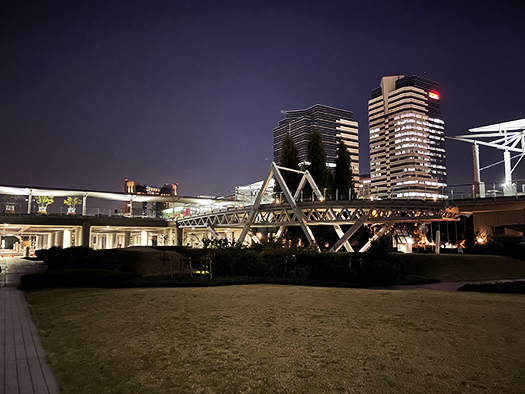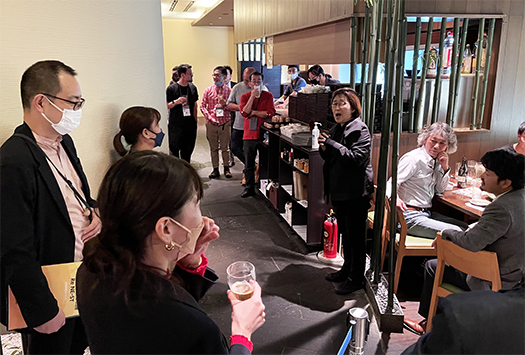

昨日は朝1番で別件1件のアポを都内で済ませたあと、
最終日のジャパンホームショーに戻りました。
その後、客足の衰える夕方4時過ぎくらいまでは
途中、進行中案件の打合せもあったのですが、
ひっきりなしの会話ラッシュでアタマの整理整頓も追いつかないほど。
今回出展はじっくり説明の必要なAI活用での新事業のご案内ということで
ごく控えめなデコレーションでのご案内にもかかわらず、
多くのみなさんがその内容に興味を持って頂き
強い関心を持っていただけたと深く感謝します。
3日間の会期中に名刺交換は都合70名以上に上り、
その他、名刺交換のない旧知のみなさんとの再会もほぼ同数程度。
前後しての会場外での出会いも多数あったので、
人間関係づくり・再構築としては非常にコスパのいい機会となりました。
今後、札幌に戻ってからいろいろ頂いたご意見を整理して
企画内容に反映させていきたいと思います。
で、会場内で建築知識ビルダーズ・木藤編集長とバッタリ。
今回の出展について10日前くらいに一斉にお知らせしたなかにお名前があり、
さっそくの返信で最終日・エコハウス大賞のイベント開催との知らせ。
終了後の「懇親会」のお誘いがあったので、
疲労困憊の最後の気力を振り絞って参加させていただきました。
エコハウス大賞については建築知識ビルダーズのHPなどをご覧ください。
ただ、開催から回数を重ねてきているけれど、
北海道の関係者には参加への強い動機が持ちにくいイベントではある。
行ってみたら懇親会も北海道人はわたしひとり。
要素技術としての省エネは北海道では完全に地域に根付いているので
その技術要素でユーザーに強くアピールするという必要性に乏しい。
そういう意味では市場環境に於いて寒冷地と温暖地とのギャップが
拡大しているというようにも思われます。
北海道では断熱や気密といった要素技術啓蒙についてほぼ30-40年前くらいが
ピーク時期で、その意識はユーザーも含めて社会に普遍化している。
その上でどういった暮らし方が求められているか、というように
作り手の感度センサーは働いているのだと思います。
日本列島で特異な積雪寒冷という条件下でどういう「シアワセ」があるか、
そういう探究がビルダーには求められているとも言えるでしょうか。
冬の寒さに耐え抜く、不自由をガマンする、みたいな心象風景から
「拡張した花鳥風月」を積極的に住宅としてどう楽しめるのか、
そんな部分が戸建て住宅の作り手には求められていると思うのです。
家の外では寒さも厳しいけれど雪景色は無上に美しくもある。
そして家の中では外気をまったく意識しない、良いいごこちが保たれている。
こういう部分でのコミュニケーションギャップは確かにあり、
いまのところ、この点は放置されてきているともいえる。
今後の「課題」とも言えるのかも知れません。さて。
English version⬇
Final Day of Japan Home Show: Launching Opinion Exchange
Subtle differences in stance between the cold climate of Hokkaido and the warm climate of Japan have created a communication gap. Now, will it be fused? …….
Yesterday, after making one other appointment in Tokyo first thing in the morning
I returned to Japan Home Show on the last day.
After that, I was in the office until about 4:00 p.m., when the number of visitors began to wane.
I had a meeting for an ongoing project on the way to the show.
I was so busy with the constant rush of conversation that I couldn’t even keep my brain in order.
This time, we exhibited our new business using AI, which needs to be explained in detail.
Despite the modest decoration of our booth, many people were interested in the contents of our presentation.
We are deeply grateful to the many visitors who were interested in the contents of the exhibition and showed a strong interest in it.
We are deeply grateful for the strong interest we received.
During the three days of the exhibition, more than 70 business cards were exchanged.
We also had about the same number of reunions with old acquaintances who had not yet exchanged business cards.
There were also many encounters outside the venue before and after the event.
It was a very cost-effective opportunity for building and rebuilding relationships.
After returning to Sapporo, we will organize the feedback we received and reflect it in our future plans.
I would like to reflect them in our future plans.
I bumped into Mr. Kito, the editor-in-chief of Architectural Knowledge Builders, in the exhibition hall.
His name was on the notice we sent out about 10 days before the exhibition, and he immediately responded with a message to the effect that he was going to be there on the last day of the exhibition.
He immediately replied that the Eco-House Award event would be held on the last day of the exhibition.
I was invited to a “reception” after the event.
I was so exhausted that I gathered up my last bit of energy and joined the party.
For more information about the Eco-House Grand Prize, please refer to the HP of Architectural Knowledge Builders.
However, although the event has been held many times since its inception
It is an event that is difficult for people in Hokkaido to have a strong motivation to participate.
When I went to the reception, I was the only one from Hokkaido.
Energy conservation as an elemental technology is completely rooted in the local community in Hokkaido.
There is little need to strongly appeal to users with this technological element.
In this sense, the gap between cold and warm regions in the market environment seems to be widening.
In this sense, it seems that the gap between cold and warm regions is widening in the market environment.
In Hokkaido, awareness of elemental technologies such as thermal insulation and airtightness peaked about 30-40 years ago.
This awareness has become universal in society, including users.
The sensitivity sensors of the makers are working to find out what kind of living style is required.
I believe that the sensitivity sensor of the creator is working.
What kind of “happiness” can be found under the unique cold and snowy conditions of the Japanese archipelago?
I think it could be said that builders are required to explore this kind of thing.
From the mental landscape of enduring the cold of winter and putting up with inconvenience
How can we actively enjoy the “extended Kacho Fu Fugetsu” as a residence?
I think this is what is required of the makers of detached houses.
Outside the house, the cold is severe, but the snowy scenery is beautiful.
And inside the house, the residents are not conscious of the outside air at all, and a good feeling of comfort is maintained.
There is certainly a communication gap in these areas.
It can be said that this point has been neglected so far.
It may be said that this is an “issue” for the future. Now.
Posted on 10月 29th, 2022 by 三木 奎吾
Filed under: リプラン&事業, 住宅マーケティング







コメントを投稿
「※誹謗中傷や、悪意のある書き込み、営利目的などのコメントを防ぐために、投稿された全てのコメントは一時的に保留されますのでご了承ください。」
You must be logged in to post a comment.